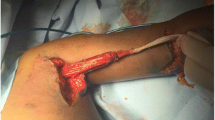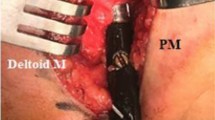Abstract
Purpose
Latissimus dorsi and teres major transfers to the lateral side of the humerus with lengthening of the pectoralis major and subscapularis muscles for residual shoulder deformity were compared in children and skeletally mature patients.
Methods
Fifteen patients (nine children, six skeletally mature patients aged three to 30 years, follow-up one to 22 years) were treated for internal shoulder contracture after birth plexus lesions: C5–C6 (seven patients); C5–7 (five patients); C5-C8-T1 (three patients, respectively). Range of movement, Mallet shoulder function score and radiographs were assessed.
Results
Pre-operatively, shoulder function restrictions were comparable in all patients. Postoperatively, external rotation, abduction and Mallet function score improved significantly (p < 0.05) in all patients except one. There were no differences in improvement between children and skeletally mature patients (p = 0.24–1.0).
Conclusions
This technique improves external rotation and abduction of the shoulder for daily living activities in children and young, skeletally mature, patients.




Similar content being viewed by others
References
Foad SL, Mehlman CT, Ying J (2008) The epidemiology of neonatal brachial plexus palsy in the United States. J Bone Joint Surg (Am) 90:1258–1264
Poyhia TH, Lamminen AE, Peltonen JI, Kirjavainen MO, Willamo PJ, Neitosvaara Y (2010) Brachial plexus birth injury: US screening for glenohural joint instability. Radiology 254:253–260
Geutjens G, Gilbert A, Helsen K (1996) Obstetric brachial plexus palsy associated with breech delivery. A different pattern of injury. J Bone Joint Surg (Br) 78:303–306
Narakas AO (1987) Obstetrical brachial plexus injuries. In: Lamb DW (ed) The paralysed hand. Churchil Livingstone, Edinburgh, pp 116–135
Foad SL, Mehlman CT, Foad MB, Lippert WC (2009) Prognosis following neonatal brachial plexus palsy: an evidence-based review. J Child Orthop 3:459–463
Pedowitz DI, Gibson B, Williams GR, Kozin SH (2007) Arthoscopic treatment of posterior glenohumeral joint subluxation. J Shoulder Elbow Surg 16:6–13
Waters PM, Smith GR, Jaramillo D (1998) Glenohumeral deformity secondary to brachial plexus birth palsy. J Bone Joint Surg (Am) 80:668–677
Hoffer MM, Phipps GJ (1998) Closed reduction and tendon transfer for treatment of dislocation of the glenohumeral joint secondary to brachial plexus palsy. J Bone Joint Surg (Am) 80:997–1001
Green WT, Tachdjian MO (1963) Correction of residual deformities of the shoulder in obstetrical palsy. J Bone Joint Surg (Am) 45:1544–1545
Hale HB, Bae DS, Waters PM (2010) Current concepts in the management of brachial plexus birth palsy. J Hand Surg (Am) 35:322–331
Bea DS, Waters PM, Zurakowski D (2003) Reliability of three classification systems measuring active motion in brachial plexus birth palsy. J Bone Joint Surg (Am) 85:1753–1738
Sibinski M, Wozniakovski B, Drobniewski M, Synder M (2010) Secondary gleno-humeral joint dysaplasia in children with persistent obstetric brachial plexus palsy. Int Orthop 34:863–867
Ezaki M, Malungpaisrope K, Harrison RJ, Kills JK, Oishi SN, Delgado M (2010) Onabotulinumtoxin A injection as an adjunct in the teratment of posterior shoulder subluxation in neonatal brachial plexus palsy. J Bone Joint Surg (Am) 92(12):2171–2177
Pearl ML, Edgerton BW, Kazimiroff PA, Burchette RJ, Wong K (2006) Arthroscopic release and latissimus dorsi transfer for shoulder internal rotation contarctures and glenohumeral deformity secondary to brachial plexus birth palsy. J Bone Joint Surg (Am) 88:564–574
Kozin SH, Boardman MJ, Chafetz RS, Williams GR, Janlon A (2010) Arthroscopic treatment of internal rotation contacture and glenohumeral dysplasia in childern with brachial plexus birth palsy. J Shoulder Elbow Surg 19:101–110
Mehlman CT, DeVoe WB, Lippert WC, Michaud LJ, Allgier AJ, Foad SL (2011) Arthroscopically assisted Severe-L’Episcopo procedure improves clinical and radiological outcomes in neonatal brachial plexus palsy patients. J Child Orthop 31:341–351
Kozin SH (2011) The evaluation and treatment of children with brachial plexus birth palsy. J Hand Surg 36-A:1360–1369
Ozturk K, Bulbul M, Demir BL, Buyukkurt CD, Ayanoglu S, Esenyel CZ (2010) Reconstruction of shoulder abduction and external rotation with latissimus dorsi and teres major tarnsfer in obstetric brachial plexus palsy. Acta Orthop Traumatol Turc 44(3):186–193
Waters PM, Bae DS (2008) The early effects of tendon transfers and open capsulorhaphy on glenohumeral deformity in brachial plexus birth palsy. J Bone Joint Surg (Am) 90:2171–2179
Di Mascio L, Chin K-F, Fox M, Sinisi M (2011) Glenoplasty for complex shoulder subluxation and dislocation in children with obstetric brachial plexus palsy. J Bone Joint Surg (Br) 93:102–107
Abzug JM, Chafetz RS, Gaughan JP, Ashworth S, Kozin SH (2010) Shoulder function after medial approach and derotational humeral osteotomy in patients with brachial plexus birth palsy. J Pediatr Orthop (Am) 30(5):469–474
Kammbhampati SBS, Birch R, Cobiella C, Chen L (2006) Posterior subluxation and dislocation of the shoulder in obstetric brachial plexus palsy. J Bone Joint Surg (Br) 88(2):213–219
Pagnotta A, Haerle M, Gilbert A (2004) Long term resultrs on abduction and external rotation of the shoulder after latissimus dorsi transfer for sequelae of obstetric palsy. Clin Orthop Rel Res 429:199–205
Bertelli JA (2009) Lengthening of subscapularis and transefr of lower trapezius in the correction of recurrent internal contracture following obstetric brachial plexus palsy. J Bone Joint Surg (Br) 91:943–948
Kirkos JM, Kyrkos MJ, Kapetanos GA, Haritidis JH (2005) Brachial plexus palsy secondary to birth injuries. Long.-erm results of anterior release and tendon transfers around the shoulder. J Bone Joint Surg (Br) 87:3231–3235
Bae DS, Zurakowski A, Avallone N, Yu R, Waters PM (2009) Sports participation in selected children with brachial plexus palsy. J Pediatr Orthop (Am) 29:496–503
Talbert RJ, Michaud LJ, Kinnett DG, Laor T, Foad SL, Schnell B, Salisbury S (2011) EMG and MRI are independently related to the shoulder external rotation function in neonatal brachial plexus palsy. J Pediatr Orthop (Am) 31(2):194–204
Hogendoorn S, Van Overvest KL, Wat I, Duisens AW, Nelissen R (2010) Structural changes in muscle and glenohumeral joint deformity in neonatal brachial plexus palsy. J Bone Joint Surg (Am) 92:935–942
Van Kooten EO, Fortuin S, Winters HA, Ritt MJ, Van der Sluijs HA (2008) Results of latissimus dorsi transfer in obstetrical brachial plexus palsy. Tech Hand Up Extrem Surg 12:195–199
Terzis JK, Kostopoulos E (2010) Our experience with secondary reconstruction of external rotation in obstetrical brachial plexus palsy. Plast Reconstr Surg 126(3):951–963
Conflict of interest
None.
Author information
Authors and Affiliations
Corresponding author
Rights and permissions
About this article
Cite this article
Chomiak, J., Dungl, P., Ošťádal, M. et al. Muscle transfers in children and adults improve external rotation in cases of obstetrical brachial plexus paralysis: a comparative study. International Orthopaedics (SICOT) 38, 803–810 (2014). https://doi.org/10.1007/s00264-013-2202-0
Received:
Accepted:
Published:
Issue Date:
DOI: https://doi.org/10.1007/s00264-013-2202-0




